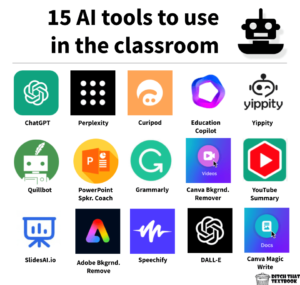Prior to this class I will say I did not know much about this AI world. When we had our first class about AI I was blown away. I was intrigued and could see how it could be a tool, but I still was not sure. Going into this past weeks debate, I wondered is it the future of education? Will this be something we will become more accustomed to.
Ditch that textbook outlines 15 AI tools teachers can use in the classroom to help teachers in their classrooms, some you may be familiar with or already use and some we have discussed in class:

My feeling towards AI is that it can definitely be used a teaching tool. GetSmater blog posted some ways that AI can help in Education , it suggest the following educational applications harness the power of AI to improve learning in students of all ages:
- Thinkster Math: Thinkster Math is a tutoring app that blends the math curriculum with a personalized teaching style. The app uses AI and ML to visualize how students think as they work through a math problem. This allows the tutor to quickly spot areas in the child’s thinking and logic that need work. It then assists them by giving them immediate, personalized feedback.
- Brainly: Students can ask homework questions on this education platform and receive automatic, verified answers from fellow students. Brainly, which ultimately helps students learn faster, uses ML algorithms to filter out spam.
- Content Technologies, Inc. (CTI): This AI company uses deep learning to create customized learning tools for students. One of these tools, JustTheFacts101, makes it easy for teachers to import syllabi into a CTI engine. The machine then uses algorithms to create personalized textbooks and coursework based on core concepts. Cram101 is another example of an AI-enhanced offering, where any textbook can be turned into a smart study guide, providing bite-sized content that’s easy to learn in a short space of time. The tool even produces multiple-choice questions, saving students time and helping them learn more effectively.
- Gradescope: This platform makes grading less time-consuming (teachers’ grading time is reduced by 70 percent or more) and provides student data that can indicate where they need additional assistance.
- Duolingo: With more than 120 million users worldwide, Duolingo has a broad audience that reaches beyond the classroom. It offers 19 languages and helps anyone using the app to learn a foreign language, building their skills over time. With quizzes and other tests, the program adapts to each user’s abilities to offer new challenges.
Some of the criticism of AI tools could be that it is teaching students to cheat. I feel as though, like many of the technologies we have discussed this semester, we can use it as a tool and we can teach our students how to use this tool properly.
This website https://owlanswer.com/ also can help students to resolve their homework issues. I can reccomend it.
Interesting choice! I found one more cool list of AI tools for students: https://productive.fish/blog/ai-in-education/ Check it out!